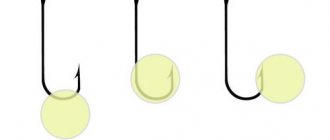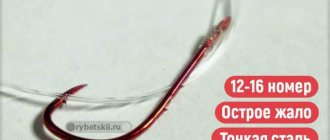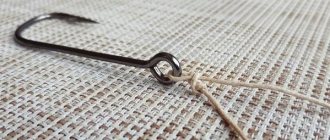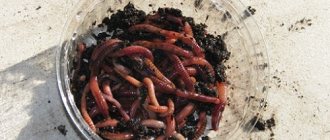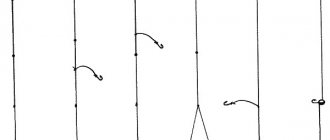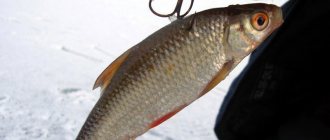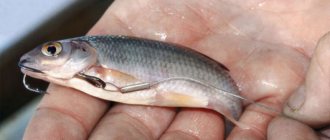Published: 09/30/2011
Boiled or canned corn kernels are among the most popular baits for fishing. Oddly enough, from some anglers, especially beginners, you hear the question: “How to properly put corn on a hook?”
For experienced fishermen, such a question may seem childish. But let’s not forget that in fishing there can be no trifles, and the success of the entire fishing trip can depend on the correct method of baiting a particular bait. In today's article we will look at the methods of planting corn and illustrate them.
On our website there was a whole article dedicated to corn for fishing, where we looked at methods of cooking corn and the difference between boiled corn and canned corn. Now it’s time to talk in more detail about the attachment method.
It would seem that it is simpler: we take a grain of corn and put it on a hook. But even here there are pitfalls. Let's look at the options more carefully:
What corn grains can be used for planting
The following types of corn can be used for hooking:
- Boiled grains.
- Canned store-bought corn (canned).
- Young milk grains (raw).
Each type of corn has its own advantages and disadvantages of use, but boiled corn is considered the best choice for using it as bait.
This can be explained by the following advantages of its use:
- When preparing boiled or steamed corn, fishermen can independently control the entire process of its preparation, which gives them the pleasure of anticipating the future catch.
- In addition, they themselves can bring the grains to the desired hardness and softness, as well as finish cooking the corn or not. Many fishermen are dissatisfied with the quality of purchased canned corn, since it is very often too small, crushed or bursting. Such grains are certainly not suitable for use as bait on a hook. By preparing corn on his own, the fisherman can select the largest and most whole grains, which will be visible to the fish from afar.
- Homemade corn can be mixed with dyes and flavorings to add extra flavor and color.
- Usually, for catching fish, corn is used not only as bait, but also as complementary food, which can take more than ten kilograms per catch. Therefore, from a purely material point of view, cooking corn yourself will cost the fisherman several times less than buying a dozen jars of canned grains.
- When a fisherman prepares corn himself, he can immediately select all the small grains that can later be used for complementary feeding, which cannot be done with canned corn, because all the grains usually have the same shape and size.
In addition, milk grains of young corn can also be used as bait, since they have a very attractive smell for carp fish. To do this, they do not need to be boiled or steamed; it will be enough to simply string the grain onto a hook, after dipping it in some kind of fish flavoring. It is important to know that young corn kernels can only be used as bait.
It is not advisable to add them to the groundbait mixture, as they simply will not perform their task.
Corn is a bait without drawbacks
Content
Corn for fishing is an irreplaceable and ideal bait without significant drawbacks. A relative disadvantage is the high energy value, due to which the fish, after a series of unsuccessful hooks, get full and lose interest in biting. Baiting carp will not lead to saturation of the fish if fine particles of bait are added to the bait.
Mamalyga for fishing is corn porridge. It has a pleasant smell, taste and attractive, noticeable appearance.
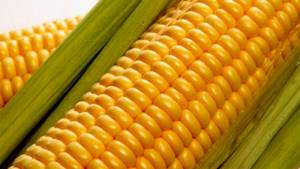
Corn is one of the most common and accessible vegetable baits
Corn in crushed and whole form has a number of advantages:
- low cost of bait and bait;
- attractive to fish with its bright color and pleasant smell;
- the bait is available to everyone without exception, you can find it in a fishing store or any hypermarket;
- does not disappear when stored at home. If a worm or maggot is used as bait, a special temperature regime must be observed. Having worms in the refrigerator is unsightly;
- the corn attachment is tightly attached to the hook;
- attractive to carp and small fish;
- corn grains and hominy easily and quickly absorb flavors and attractants;
- prepared at home, the fisherman independently selects the desired softness of the grains;
- long shelf life without deterioration in visual quality.
Hook selection

There are the following rules for choosing the right hooks for corn baits:
- Hooks must have sharp tips and be made of high-quality material.
- Hooks should be thin.
- The size of the hooks is selected depending on the size of the fish that is intended to be caught.
- To catch small fish such as roach, silver bream, perch and crucian carp, hooks numbered 17-20 should be used.
- To catch large fish such as bream, carp, carp and others, large hooks with numbers 8-12 should be used.
- You can also use hooks with two tips for combined baits with corn and other ingredients.
Methods for hooking corn

Among anglers, there are two main methods of baiting
such bait:
Directly to the point of the hook
All types of corn are used, and it is better to plant grains that differ from each other in size. The size and amount of corn directly depends on the size of the hook.
To catch large fish (carp) use 5-8 grains, for smaller fish (crucian carp) - up to two corn grains.
Hair rig method (Hair rig for carp)
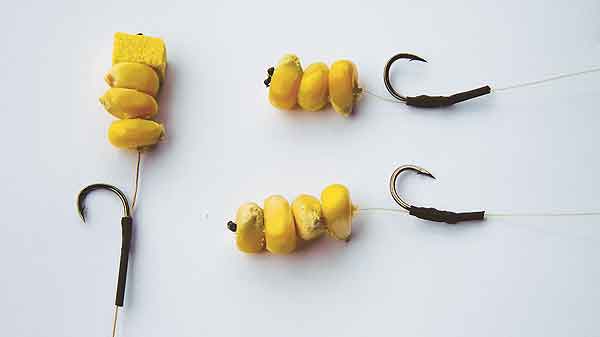
More often, this type of equipment is used for carp fishing.
For this you need:
- hook;
- fishing line, preferably braided;
- small tube (silicone);
- needle;
- stopper for boilies.
Installation of hair equipment
We make a small loop on the fishing line, which will be a stopper for the corn. We “pass” the fishing line through the tube, and then through the shank of the hook so that the bend of the sting is on the other side of the fishing line. We measure the length of hair that is needed, and fix the fishing line on the hook. We pierce the corn grain with a needle and place it on a loop of hair, securing it with a boilie stopper.
The corn on the hair is located differently depending on its length:
- close to each other (up to 6 grains on short hair);
- at a distance of 6-9 mm from each other (for long hair with several stoppers).
The video clearly shows the process of making the installation of hair equipment with a hook and corn for carp and crucian carp:
With a hair rig, good and frequent bites are due to the fact that the fish does not see the hook in the corn grain.
This rigging method is especially popular for carp fishing.
Planting one grain of corn
Placing one grain of corn on a hook is done in the following different ways:
- Nozzle grain through the middle. To do this, pierce the grain with a hook through the entire grain in such a way that it is not damaged and remains intact.
- Grain edge attachment. To do this, only pierce the skin of the grain with a hook so that most of it is free. In this case, the tip of the hook should be brought out so that the fish, having swallowed the bait, cannot free itself.
- Nozzle through the middle to the side. To do this, you should pass the tip of the hook through the middle of the grain and bring it out on one of its sides.
All methods with a single grain bait are used for catching small species of fish (roach, crucian carp, silver bream, rudd and others).
It is best to use such a bait in cases where the fish’s bite is very active, and it swallows everything that is offered to it.
Planting multiple grains
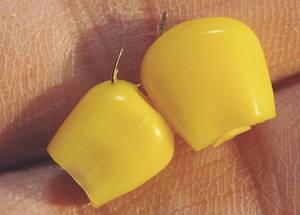
To attach several grains, you can use both small and large hooks.
This attachment is done as follows:
- Pass a hook through each grain (no more than eight pieces) so that its tip captures only the skin of the grain.
- Carefully push all the grains onto the shank of the hook. They should look like some kind of garland.
By planting the grains in this way, they will look more natural and attract fish. Typically this method is used to catch carp and crucian carp. For the latter, a nozzle of three grains will be quite sufficient.
"Sandwich" planting
This attachment is used when the bite is weak and you need something to attract fish that do not want to bite only on corn. The additional component is usually of animal origin, and therefore, with its movements and appearance, it perfectly attracts the attention of many species of fish.
Most often, a “sandwich” is made from the following components:
- Made from corn and red worm.
- Made from corn and maggots.
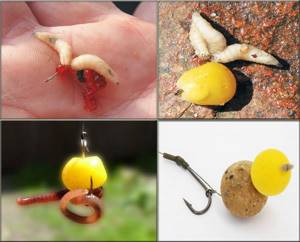
A corn and worm “sandwich” is made as follows:
- You should place the corn kernel on the hook first as it will sit more firmly on the hook. It is advisable to thread the point of the hook through the middle of the grain.
- Next, you should attach a worm to the same hook. To do this, the hook tip should be pulled through the “head” of the worm, which has a slightly larger base than the “tail”. Then, you need to remove the hook tip through the middle of the worm and pull it through again, only this time through the “tail” of the worm, forming a kind of ring from it. In this way he will no longer be able to fall off the hook.
A “sandwich” of maggot and corn is made this way:
- Place at least two maggots on the hook in such a way that the tip of the hook first passes through the “head of the larva,” which is thicker than its “tail.” Also, the “head” can be distinguished by two black dots that resemble the eyes of a maggot.
- Next, two kernels of corn should be placed on the same hook so that the hook tip only penetrates their skin and comes out.
Typically, the following types of fish are caught using such baits:
- Carp.
- Guster.
- Ram.
- Bream.
- Crucian carp.
- Zander.
In addition, you can use such a bait all year round, since the fish contains both plant and animal components, so the fish will bite at least one of them.
Tips and tricks
- Most anglers find that the most effective way to hook corn is to poke through the side of the grain. Why? Small fish cannot steal the bait, the sting is not exposed, and when swallowed, it easily pierces the lower lip of the carp.
- To reduce the number of slips, the tip of the hook can be threaded through the side and then brought down. Here, the corn grain does not have a dense skin, so when biting, the tip easily passes through the bait and catches the fish.
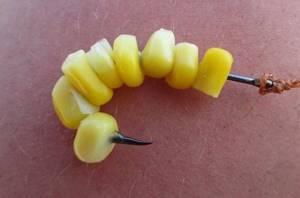
Corn planted on the side is the best option for catching carp
- When fishing with a “sandwich”, baits such as corn and a worm must be correctly placed on the hook. It is best to pierce the grain and insert it from the side. First thread the worm through the head, then bring the hook to its body. Then release the sting and bring it in from the tail side. This will allow the worm to stay securely on the hook and not cover the corn.
- When fishing for corn, don't neglect odd or small grains. Usually the bite on them is no worse.
- Always check how firm the corn is before hooking it on the hook. If the grain is too soft, don't use it. This is a waste of time, because the bait will most likely fly off the hook while casting.
Various ways to hook corn can be found in the video:
Hair editing
A corn hair rig is used to prevent overly suspicious fish (such as carp) from feeling the metal hook and swimming away without swallowing the bait. In addition, such equipment makes it possible to avoid piercing soft grains onto the hook, from where they can be caught when casting.
As the name suggests, a “hair rig” looks like a “hair” on which the bait is attached.
In order to make it, you should prepare the following materials:
- Hook with size from four to eight.
- Leash material. It should be free of twists, knots and kinks.
- Silicone tube. It is needed to straighten the “hair” and prevent it from bending.
- A special needle for mounting, which has a small lock and can smoothly move the bait onto the “hair”.
- Stoppers made of plastic. They are needed to hold the nozzle and prevent it from slipping.
The installation principle of this equipment is as follows:
- Cut a piece of fishing line twenty centimeters long.
- Make a loop at the end of this fishing line.
- Pass the loop through the eye of the hook from the side of its tip so that only three centimeters remain between the edge of the hook and the tip of the loop.
- To prevent bending, you need to put a silicone tube on the shank of the hook using an installation needle. When doing this, you need to be very careful not to cut through the tube with the needle.
- Pull the leash material through the silicone tube.
- Attach the hook to the fishing line.
- Make a regular knot from a securing loop.
- After this you can hook the bait. Three grains of corn will be enough for her. Before planting it, use a hook to make a small hole in the middle of each grain.
- Then you need to stretch the needle into the holes on the grains and use it to put them on the “hair”.
- The final stage of installation is the installation of a plastic stopper on the “hair”.
How to cook corn for carp
What kind of corn can be used for carp fishing:
- milk grains;
- cooked;
- fresh;
- canned.
When choosing bait, you need to take into account the fishing location, as well as the method:
- Raw grains are an excellent treat for fish. This type of bait is best used for catching small specimens.
- Canned corn is sold in any supermarket. This is a finished product. Therefore, it does not need to be cooked. Advantages:
- holds tightly;
- affordable price;
- It is stored for quite a long time.
There are various varieties of canned corn available in stores. There are no specific recommendations for selection.
You can visit specialized fishing stores. These stores sell canned corn intended for carp fishing.
How is it different from the store one:
- various flavors;
- various dyes;
- grains of the same size.
The main advantage of such a product is its shelf life (1–2 years). If this option does not suit you, then pay attention to boiled corn.
Why do they prefer boiled corn:
- Saving money. Because feeding fish requires a lot of corn.
- I would like to prepare my own bait.
Recipe:
- First, rinse all the grains with regular running water.
- Then soak them for 1-3 days. You can add hemp, garlic or vanilla for flavor.
- If the grains are slightly swollen, then proceed to the next step.
- Place the grains in a saucepan, add water and turn on the gas.
- Some people add sugar (one tablespoon per liter of water).
- Cook for 30–60 minutes.
- The prepared “dish” should be infused for 1–2 days.
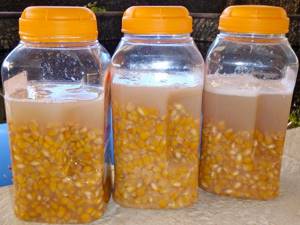
Boiled corn is infused
It will be useful for you to watch a video about drunken corn - this is the name given to grains that have gone through the fermentation process. Carp love them very much.
Blitztips
- In order to make the bait more natural, you should use both small and large corn grains at the same time;
- If you notice that the grain does not hold well on the hook, then there is no need to risk casting it, since it will still fly off when casting and there will be an “empty” hook in the water. You should immediately replace the spoiled grain with a new one;
- It is not recommended to use corn that was cooked more than three days ago as bait, as it will no longer have as strong a smell as fresh;
- It is advisable to store corn baits in tightly closed containers to prevent their specific aroma from eroding.
Advantages and disadvantages of corn
Positive aspects of the bait:
- it has the highest taste qualities;
- due to its spectacular aroma, it is able to attract a large number of aquatic inhabitants;
- This is a universal bait that suits the taste of different types of fish;
- it is very affordable in terms of cost and popularity. Finding such bait will not be difficult;
- It will also not be difficult to see the bait in a very muddy body of water. This is because corn has a bright and rich yellow color.
Negative aspects of the bait:
- it is necessary to prepare the nozzle correctly. If you overcook it, the corn will constantly fly off the hook.
Which corn to choose?
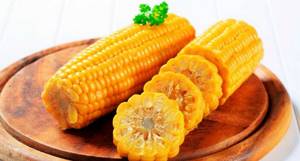
You have several options as to where you can get bait for your future fishing trip. Firstly, you can go to any store and buy a ready-made canned nozzle, and secondly, buy a frozen product and cook it yourself, and thirdly, use a rubber analogue of grains. Next we will consider all the options.
Canned bait from a jar
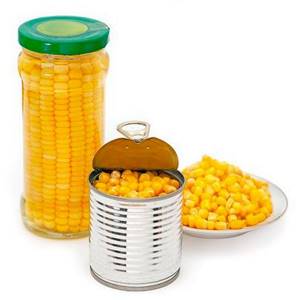
A store-bought can of corn may work as a fishing bait, but there is a small catch. This bait is very soft, although aromatic, and can easily fly off the hook. It happens that it doesn’t even reach the depth of the water on the hook. In this case, you will have to hang it again and hope that everything works out.
Boiled bait

If you wish, you can boil the bait yourself. But in this case, it is important not to overdo it so that it does not turn out very soft (like canned food). Experienced fishermen advise preparing such a bait for no more than ten minutes. Of course, it may seem undercooked to you. There is a little secret: after cooking, the corn must be immediately placed in a thermos or other hermetically sealed jar. It is there that the bait will be steamed and cooked until ready.
The corn head should be of medium hardness. So that it does not fly off the hook, and the fish can swallow it. This bait is not very fragrant, like from a jar, but our inhabitants of the reservoir like it.
To summarize, we can say with confidence that it is the second option that is more suitable for fishing. And knowing little tricks, you will never overcook the product.

